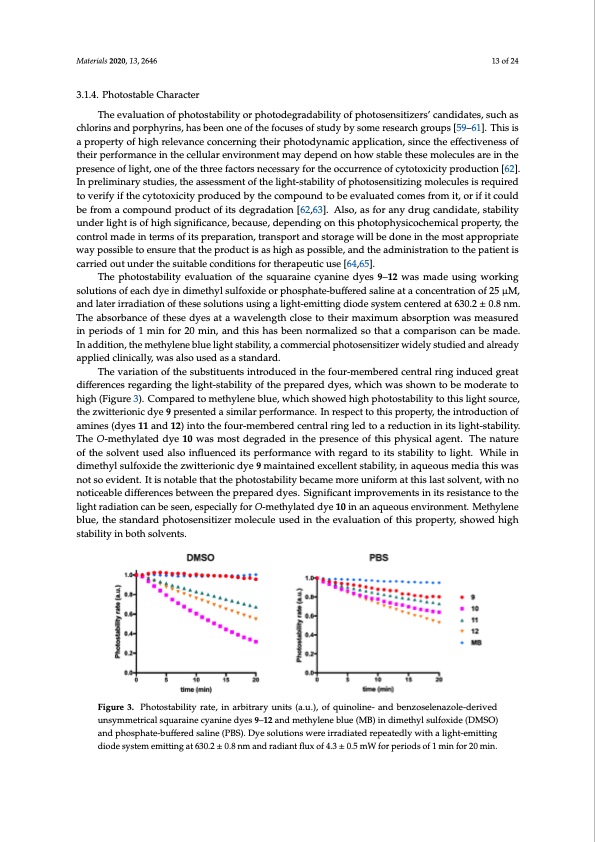
PDF Publication Title:
Text from PDF Page: 013
Materials 2020, 13, 2646 13 of 24 3.1.4. Photostable Character The evaluation of photostability or photodegradability of photosensitizers’ candidates, such as chlorins and porphyrins, has been one of the focuses of study by some research groups [59–61]. This is a property of high relevance concerning their photodynamic application, since the effectiveness of their performance in the cellular environment may depend on how stable these molecules are in the presence of light, one of the three factors necessary for the occurrence of cytotoxicity production [62]. In preliminary studies, the assessment of the light-stability of photosensitizing molecules is required to verify if the cytotoxicity produced by the compound to be evaluated comes from it, or if it could be from a compound product of its degradation [62,63]. Also, as for any drug candidate, stability under light is of high significance, because, depending on this photophysicochemical property, the control made in terms of its preparation, transport and storage will be done in the most appropriate way possible to ensure that the product is as high as possible, and the administration to the patient is carried out under the suitable conditions for therapeutic use [64,65]. The photostability evaluation of the squaraine cyanine dyes 9–12 was made using working solutions of each dye in dimethyl sulfoxide or phosphate-buffered saline at a concentration of 25 μM, and later irradiation of these solutions using a light-emitting diode system centered at 630.2 ± 0.8 nm. The absorbance of these dyes at a wavelength close to their maximum absorption was measured in periods of 1 min for 20 min, and this has been normalized so that a comparison can be made. In addition, the methylene blue light stability, a commercial photosensitizer widely studied and already applied clinically, was also used as a standard. The variation of the substituents introduced in the four-membered central ring induced great differences regarding the light-stability of the prepared dyes, which was shown to be moderate to high (Figure 3). Compared to methylene blue, which showed high photostability to this light source, the zwitterionic dye 9 presented a similar performance. In respect to this property, the introduction of amines (dyes 11 and 12) into the four-membered central ring led to a reduction in its light-stability. The O-methylated dye 10 was most degraded in the presence of this physical agent. The nature of the solvent used also influenced its performance with regard to its stability to light. While in dimethyl sulfoxide the zwitterionic dye 9 maintained excellent stability, in aqueous media this was not so evident. It is notable that the photostability became more uniform at this last solvent, with no noticeable differences between the prepared dyes. Significant improvements in its resistance to the light radiation can be seen, especially for O-methylated dye 10 in an aqueous environment. Methylene blue, the standard photosensitizer molecule used in the evaluation of this property, showed high stability in both solvents. Figure 3. Photostability rate, in arbitrary units (a.u.), of quinoline- and benzoselenazole-derived unsymmetrical squaraine cyanine dyes 9–12 and methylene blue (MB) in dimethyl sulfoxide (DMSO) and phosphate-buffered saline (PBS). Dye solutions were irradiated repeatedly with a light-emitting diode system emitting at 630.2 ± 0.8 nm and radiant flux of 4.3 ± 0.5 mW for periods of 1 min for 20 min.PDF Image | Photophysicochemical Light Antiproliferative vs cancer

PDF Search Title:
Photophysicochemical Light Antiproliferative vs cancerOriginal File Name Searched:
materials-13-02646-v2.pdfDIY PDF Search: Google It | Yahoo | Bing
Cruise Ship Reviews | Luxury Resort | Jet | Yacht | and Travel Tech More Info
Cruising Review Topics and Articles More Info
Software based on Filemaker for the travel industry More Info
The Burgenstock Resort: Reviews on CruisingReview website... More Info
Resort Reviews: World Class resorts... More Info
The Riffelalp Resort: Reviews on CruisingReview website... More Info
| CONTACT TEL: 608-238-6001 Email: greg@cruisingreview.com | RSS | AMP |